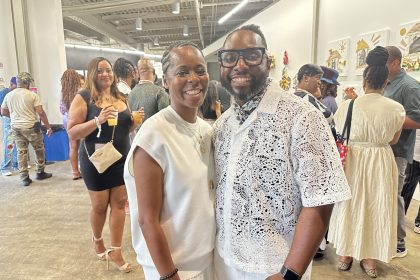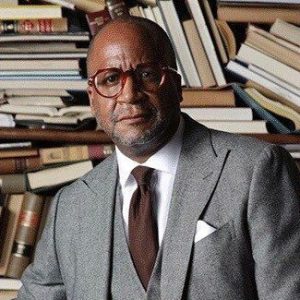
Artist and instructor Priscilla Phifer creates works of art utilizing objects like cardboard, plastic, metal, stone, wood and glass. The 70-year-old decoupage instructor describes herself as “primarily a scrape, drag, and drip and drop acrylic abstract expressionist painter.”
Rolling out recently spoke with Phifer about her inspiration, creative process and who she considers iconic.
What led you to art in general and to your art form(s) in particular?
Art has always been therapeutic from childhood, when I learned how to do collages, decoupage and other “kid art” in elementary school and continued doing them at home. Additionally, my mother and paternal grandmother were a source of inspiration. They introduced the girls in my family to a variety of arts and crafts: sewing, floral arranging, the art of entertaining, knitting, crocheting, etc. But it wasn’t until late adulthood that I fell in love with floral arranging, decoupage and painting.
Adding current art form of acrylic painting on canvas evolved from teaching, creating, and selling decoupage items. Eventually, I was strongly encouraged by my husband Randolph, son and daughter-in-law, Drake and Monique Parnell, respectively, to also consider taking a class in painting, to “see how good you are.” They thought that if I could do decoupage to make items look like a painting then I could paint! So my first class was at the Birmingham Bloomfield Art Center in Birmingham, MI, in Sept 2014, following hip replacement, and it was grueling from 9 to 3:30 weekly for six weeks!! I took the same class in February 2015 and currently am taking another one at a The Community House, also in Birmingham, which is for eight weeks, ending June 15. The feedback from both instructors gave me more confidence to continue down this path, and I’m so glad I did.
Another influence was during a time when I borrowed art from a gallery to lend ambiance to my retail shop in the mid-eighties and noticing the effect it had on my customers and me. Primarily abstract, (Varnette Honeywood, Muleme and others), the art sold right off the walls before my own merchandise sold!
Do you most often actively seek inspiration or does it find you? Or is there a combination of the two?
It’s a combination of the two. When I am stuck on an idea or want to see what other artists are doing or have done, whether they are emerging, established or deceased. I sometimes explore to see if their style or technique is something that I could incorporate, putting my own spin on the work. As an emerging abstract artist, I don’t copy their work, but am inspired by it. For the most part, I believe inspiration finds me.
Have you and your artistry ever been involved in traditional business? If so, how?
Yes. In the late ’90s, I provided floral arrangements and/or holiday decorations for a bank, a popular restaurant, an office building cafeteria, and other businesses and individuals.
I have donated paintings and decoupage items to public service charities for their silent auctions to help raise dollars
In addition to mastering their art, what other skill sets do you recommend that artists develop if they want to be successful?
I would suggest continuous learning through classroom instruction, visiting museums, taking Internet tutorials, and through other means of gaining knowledge about the craft, the industry and artists. I would also recommend that they research the type art they appreciate and to affiliate with art organizations and artists, frequent museums, and find the environment that stimulates their curiosity and motivates them to action. I’ve been told by instructors and some artists that “real artists” work in their studio every day, whether it’s to do administrative work or to stay motivated and inspired. Now that I consider myself a real artist, though emerging, I have heeded their advice.
For marketing purposes, artists may want to consider occasional donations of their art to family, friends, businesses and charitable organizations to help get their name out to the community.
Developing a website or blog could be helpful, but you really have to work it and update regularly. Though I have one (www.rareambiance.com), I’m am embarrassed for not updating it in a very long while, but aim to do so in the near future to post current works.
Do you think that there are any widely held misconceptions about art and/or artists? If so, what are they and how do you work to dispel them?
In my dealings with teaching decoupage, for example, students — young, old, and in between — are surprised that they need not be a traditional artist for this craft and yet can create items as if they could draw or paint like a trained artist. Even I thought this way about painting on canvas, and I learned that acrylic and oil paintings can be created without brush, as most of my paintings are, and one can be self-taught.
Another misconception regards pricing. I’ve heard some say that pricing your art too low may discourage real collectors from purchasing your art. Or that if your art sells out quickly, say at an art show, it’s priced too low and therefore should be justification to raise prices. If this is true, then the question becomes how much of an increase should there be: slight, moderate or significant price increase? I don’t really know the answer to this, but hope to find out in the near future. In the meantime, one of my objectives is to get my art in as many households as possible without going bankrupt!
“Show and tell” is one way to dispel these misconceptions.
Name three books, works, performances or exhibits that changed how you view life, yourself or both.
A virtual unknown, I have enjoyed following author/blogger Linda Tirado who writes about poverty and the social ills associated with this condition. She talks about the working poor and the “bad” decisions that people like her make and why. Though I’ve read many books and other writings on the subject, her writing style has made me less judgmental and more understanding of the poor. Though I know people who once lived in extreme poverty, they didn’t talk about it on this level and in such detail. Reading Tirado’s situation has only reinforced what I’ve always known and that is that you can be up one day and down the next, becoming homeless, hungry and unemployed or unemployable.
Why do you consider continued learning important?
It helps to keep you focused and connected with students and scholars in the art field.
What affirmations do you repeat to yourself that contribute to your success?
I forgot who said this, but I believe that “No one can make you feel inferior without your consent.” or to tactfully avoid negative people who would contribute to impeding your progress.
What role does art have in the community? What role would you like to see art play in the community?
To me, art has a similar effect on people as sports activities. Their lives may be different, but engage each other when in the realm of the art world together, potentially broadening worldviews and leading to more support of the art institutions and local artists.
What role does technology play in your day-to-day life? How do you utilize it?
I would be the first to acknowledge that I lag behind most friends and family in terms of technology such as the latest iPhones/Pads and other hand-held devices, but realize this technology can be utilized to benefit any business.
What software, app or other technological innovation has made the biggest difference in your life and/or career.
The Internet, YouTube and email and digital cameras.
What is your favorite vacation destination and why?
New York and Chicago for the extensive variety of entertainment, art, vibrancy, dynamism, and the overall excitement of big city life.
If you could change one thing about yourself, what would it be?
To have more confidence.
What does it take to be iconic? In your estimation, who has achieved that status?
Most often, I think its people, images and characters who have made such an impact on society or the world that they become household names and frames of reference in discussions. Oftentimes, they are identified by only one name. There are many icons, but the late Supreme Court Justice Thurgood Marshall achieved this status long ago, leaving a lifetime legacy and impact with his decision about Brown vs. the Board of Education in 1954, when I was a fourth grader who integrated an all white school.
View more of Phifer’s artwork in the gallery.





































